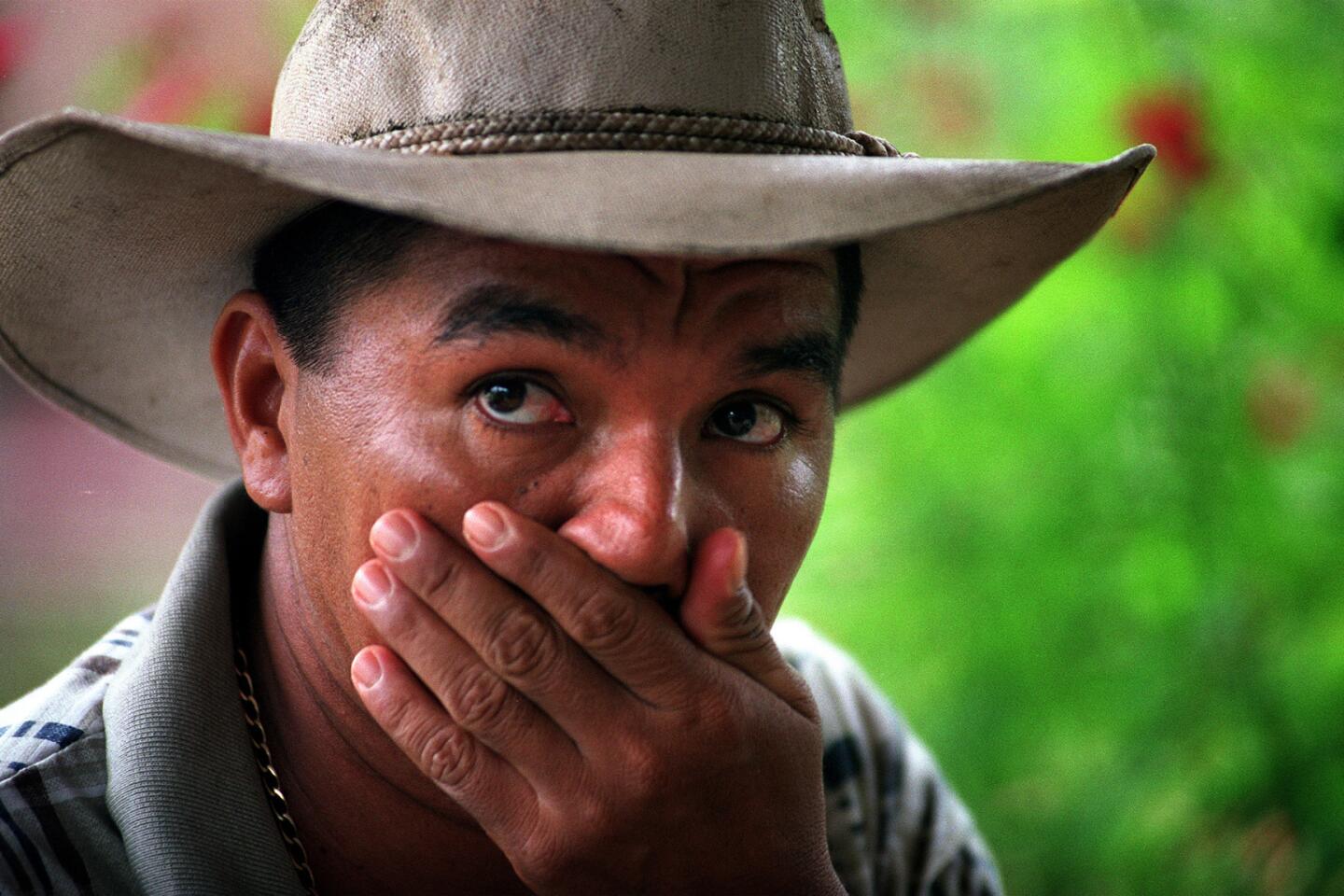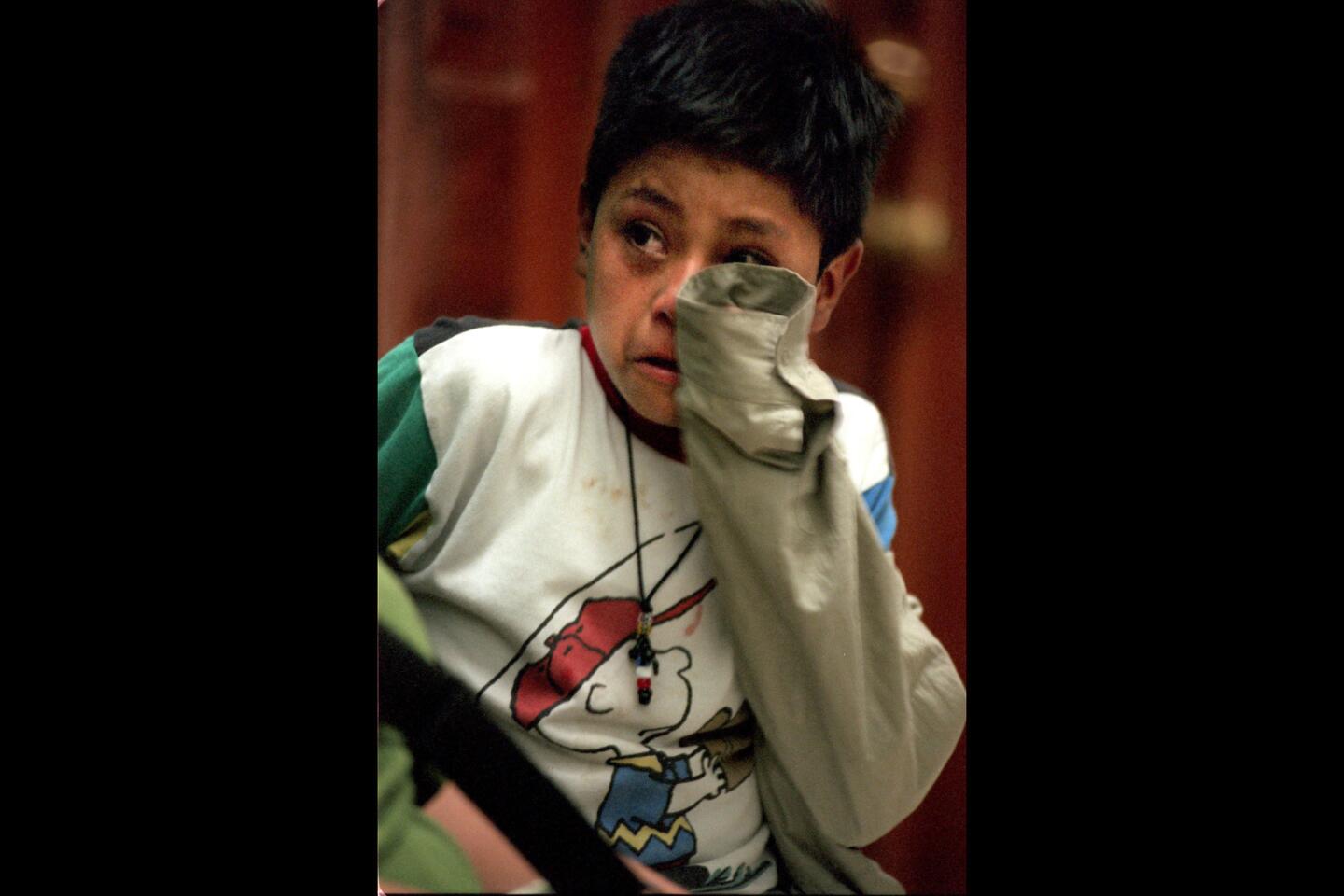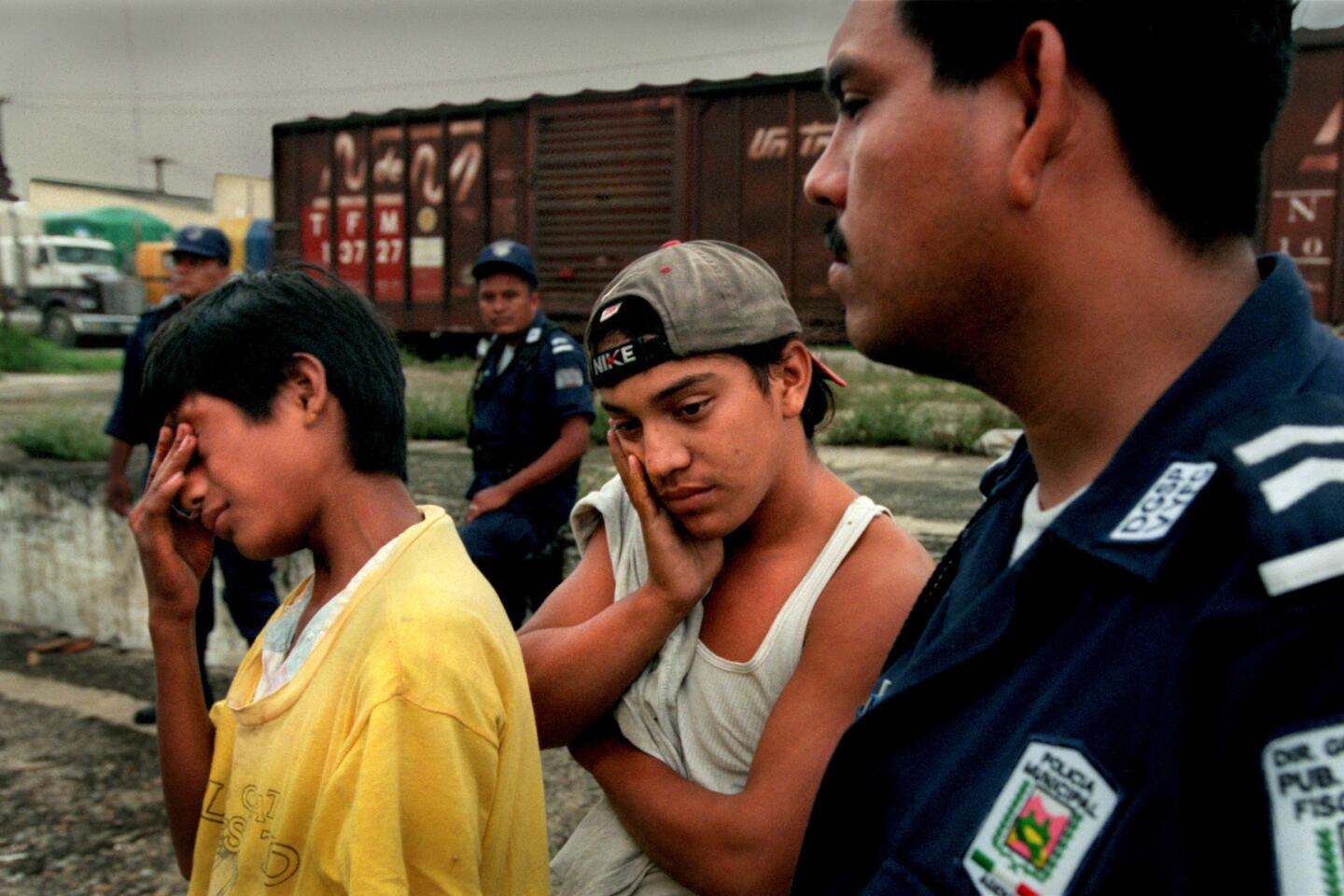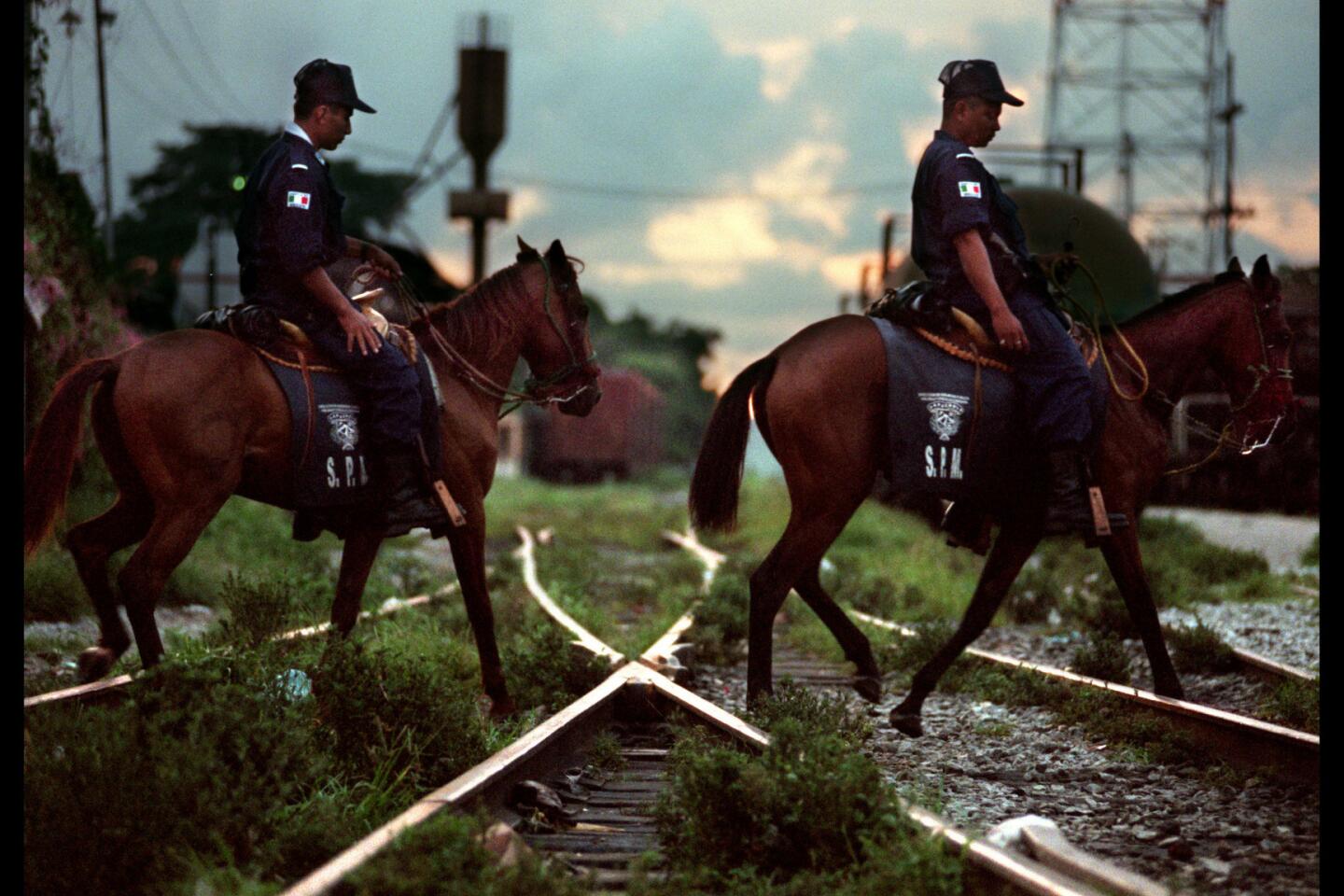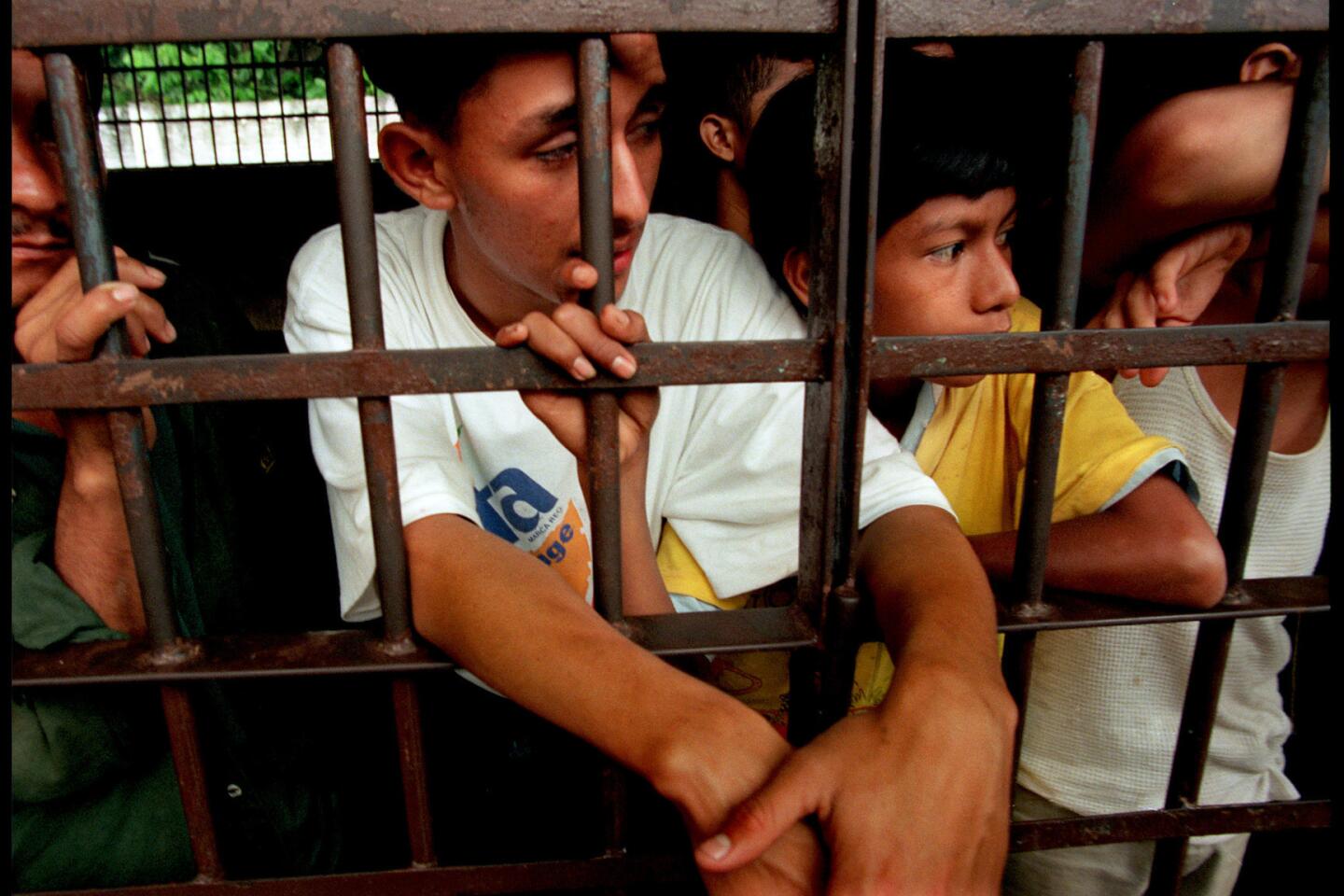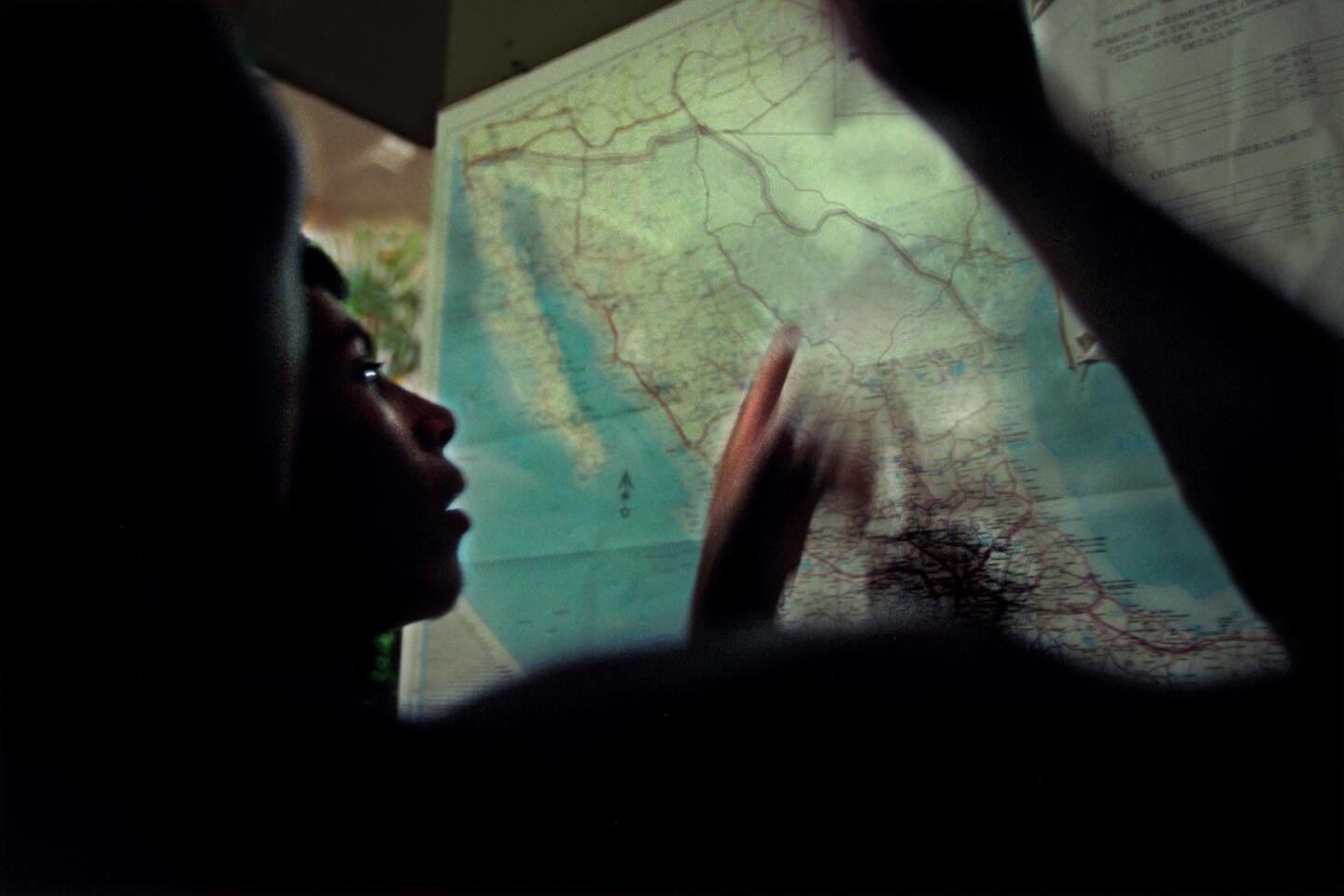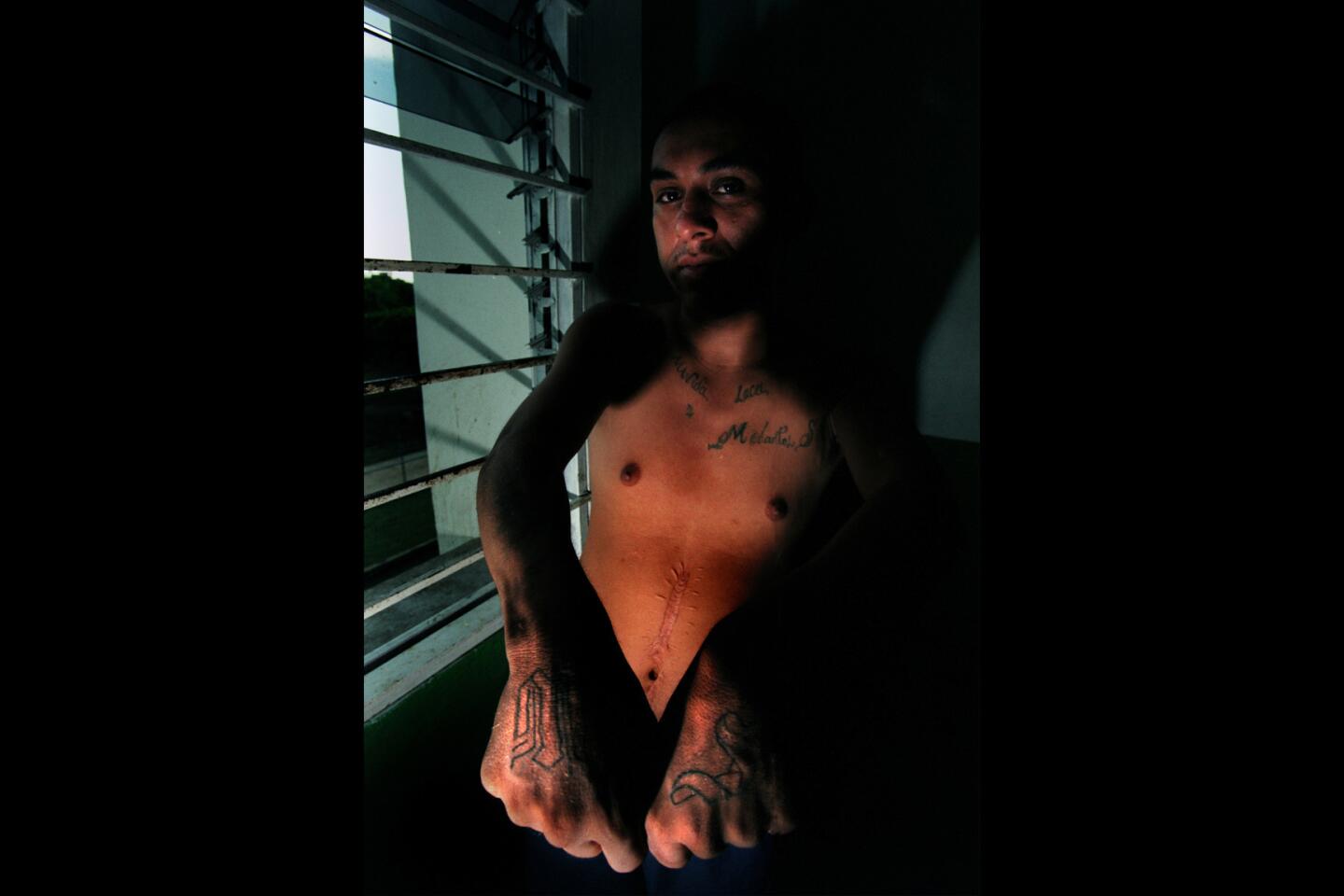Enrique’s Journey | Chapter Two: Badly Beaten, a Boy Seeks Mercy in a Rail-Side Town
- Share via
The day’s work is done at Las Anonas, a rail-side hamlet of 36 families in the state of Oaxaca, Mexico, when a field hand, Sirenio Gomez Fuentes, sees a startling sight: a battered and bleeding boy, naked except for his undershorts.
It is Enrique.
He limps forward on bare feet, stumbling one way, then another. His right shin is gashed. His upper lip is split. The left side of his face is swollen. He is crying.
Gomez hears him whisper, “Give me water, please.”
The knot of apprehension in Sirenio Gomez melts into pity. He runs into his thatched hut, fills a cup and gives it to Enrique.
“Do you have a pair of pants?” Enrique asks.
Gomez dashes back inside and fetches some. There are holes in the crotch and the knees, but they will do. Then, with kindness, Gomez directs Enrique to Carlos Carrasco, the mayor of Las Anonas. Whatever has happened, maybe he can help.
Enrique hobbles down a dirt road into the heart of the little town. He encounters a man on a horse. Could he help him find the mayor?
“That’s me,” the man says. He stops and stares. “Did you fall from the train?”
Again, Enrique begins to cry.
Mayor Carrasco dismounts. He takes Enrique’s arm and guides him to his home, next to the town church. “Mom!” he shouts. “There’s a poor kid out here! He’s all beaten up.” Carrasco drags a wooden pew out of the church, pulls it into the shade of a tamarind tree and helps Enrique onto it.
Lesbia Sibaja, the mayor’s mother, puts a pot of water on to boil and sprinkles in salt and herbs to clean his wounds. She brings Enrique a bowl of hot broth, filled with bits of meat and potatoes.
He spoons the brown liquid into his mouth, careful not to touch his broken teeth. He cannot chew.
Townspeople come to see. They stand in a circle. “Is he alive?” asks Gloria Luis, a stout woman with long black hair. “Why don’t you go home? Wouldn’t that be better?”
“I am going to find my mom,” Enrique says, quietly.
He is 17. It is March 24, 2000. Eleven years before, his mother had left home in Tegucigalpa, Honduras, to work in the United States. She did not come back, and now he is riding freight trains up through Mexico to find her.
Gloria Luis looks at Enrique and thinks about her own children. She earns little; most people in Las Anonas make 30 pesos a day, roughly $3, working the fields. She digs into a pocket and presses 10 pesos into Enrique’s hand.
Several other women open his hand, adding 5 or 10 pesos each.
Mayor Carrasco gives Enrique a shirt and shoes. He has cared for injured immigrants before. Some have died. Giving Enrique clothing will be futile, Carrasco thinks, if he can’t find someone with a car who can get the boy to medical help.
Adan Diaz Ruiz, mayor of San Pedro Tapanatepec, the county seat, happens by in his pickup.
Carrasco begs a favor: Take this kid to a doctor.
Diaz balks. He is miffed. “This is what they get for doing this journey,” he says. Enrique cannot pay for any treatment. Why, Diaz wonders, do these Central American governments send us all their problems?
Looking at the small, soft-spoken boy lying on the bench, he reminds himself that a live migrant is better than a dead one. In 18 months, Diaz has had to bury eight of them, nearly all mutilated by the trains. Already today, he has been told to expect the body of yet another, in his late 30s.
Sending this boy to a doctor would cost the county $60. Burying him in a common grave would cost three times as much. First, Diaz would have to pay someone to dig the grave, then someone to handle the paperwork, then someone to stand guard while Enrique’s unclaimed body is displayed on the steamy patio of the San Pedro Tapanatepec cemetery for 72 hours, as required by law.
All the while, people visiting the graves of their loved ones would complain about the smell of another rotting migrant.
“We will help you,” he tells Enrique finally.
He turns him over to his driver, Ricardo Diaz Aguilar. Inside the mayor’s pickup, Enrique sobs, but this time with relief. He says to the driver, “I thought I was going to die.”
An officer of the judicial police approaches in a white pickup. Enrique cranks down his window. Instantly, he recoils. He recognizes both the officer and the truck.
The officer, too, seems startled.
For a moment, the officer and the mayor’s driver discuss the new dead immigrant. Quickly, the policeman pulls away.
“That guy robbed me yesterday,” Enrique says. The policeman and a partner had taken 100 pesos from him and three other migrants at gunpoint in Chahuites, about five miles south.
The mayor’s driver is not surprised. The judicial police, he says, routinely stop trains to rob and beat immigrants.
The judiciales--the Agencia Federal de Investigacion--deny it.
In San Pedro Tapanatepec, the driver finds the last clinic still open that night.
::
Perseverance
When Enrique’s mother left, he was a child. Six months ago, the first time he set out to find her, he was still a callow kid. Now he is a veteran of what has become a perilous children’s pilgrimage to the north.
Every year, experts say, an estimated 48,000 youngsters like Enrique from Central America and Mexico enter the United States illegally and without either of their parents. Many come looking for their mothers. They travel any way they can, and thousands ride the tops and sides of freight trains.
They leap on and off rolling train cars. They forage for food and water. Bandits prey on them. So do street gangsters deported from Los Angeles, who have made the train tops their new turf. None of the youngsters have proper papers. Many are caught by the Mexican police or by la migra, the Mexican immigration authorities, who take them south to Guatemala.
Most try again.
Like many others, Enrique has made several attempts.
The first: He set out from Honduras with a friend, Jose del Carmen Bustamante. They remember traveling 31 days and about 1,000 miles through Guatemala into the state of Veracruz in central Mexico, where la migra captured them on top of a train and sent them back to Guatemala on what migrants call el bus de lagrimas, the bus of tears. These buses make as many as eight runs a day, deporting more than 100,000 unhappy passengers every year.
The second: Enrique journeyed by himself. Five days and 150 miles into Mexico, he committed the mistake of falling asleep on top of a train with his shoes off. Police stopped the train near the town of Tonala to hunt for migrants, and Enrique had to jump off. Barefoot, he could not run far. He hid overnight in some grass, then was captured and put on the bus back to Guatemala.
The third: After two days, police surprised him while he was asleep in an empty house near Chahuites, 190 miles into Mexico. They robbed him, he says, and then turned him over to la migra, who put him, once more, on the bus to Guatemala.
The fourth: After a day and 12 miles, police caught him sleeping on top of a mausoleum in a graveyard near the depot in Tapachula, Mexico, known as the place where an immigrant woman had been raped and, two years before that, another was raped and stoned to death. La migra took Enrique back to Guatemala.
The fifth: La migra captured him as he walked along the tracks in Queretaro, north of Mexico City. Enrique was 838 miles and almost a week into his journey. He had been stung in the face by a swarm of bees. For the fifth time, immigration agents shipped him back to Guatemala.
The sixth: He nearly succeeded. It took him more than five days. He crossed 1,564 miles. He reached the Rio Grande and actually saw the United States. He was eating alone near some railroad tracks when migra agents grabbed him. They sent him to a detention center, called El Corralon, or the corral, in Mexico City. The next day they bused him for 14 hours, all the way back to Guatemala.
It was as if he had never left.
This is his seventh try, and it is on this attempt that he suffers the injuries that leave him in the hands of the kind people of Las Anonas.
Here is what Enrique recalls:
It is night. He is riding on a freight train. A stranger climbs up the side of his tanker car and asks for a cigarette.
Trees hide the moon, and Enrique does not see two men who are behind the stranger, or three more creeping up the other side of the car. Scores of migrants cling to the train, but no one is within shouting distance.
One of the men reaches a grate where Enrique is sitting. He grabs Enrique with both hands.
Someone seizes him from behind. They slam him face down.
All six surround him.
Take off everything, one says.
Another swings a wooden club. It cracks into the back of Enrique’s head.
Hurry, somebody demands. The club smacks his face.
Enrique feels someone yank off his shoes. Hands paw through his pants pockets. One of the men pulls out a small scrap of paper. It has his mother’s telephone number. Without it, he has no way to locate her. The man tosses the paper into the air. Enrique sees it flutter away.
The men pull off his pants. His mother’s number is inked inside the waistband. But there is little money. Enrique has less than 50 pesos on him, only a few coins that he has gathered begging. The men curse and fling the pants overboard.
The blows land harder.
“Don’t kill me,” Enrique pleads.
His cap flies away. Someone rips off his shirt. Another blow finds the left side of his face. It shatters three teeth. They rattle like broken glass in his mouth.
One of the men stands over Enrique, straddling him. He wraps the sleeve of a jacket around Enrique’s neck and starts to twist.
Enrique wheezes, coughs and gasps for air. His hands move feverishly from his neck to his face as he tries to breathe and buffer the blows.
“Throw him off the train,” one man yells.
Enrique thinks of his mother. He will be buried in an unmarked grave, and she will never know what happened.
“Please,” he asks God, “don’t let me die without seeing her again.”
The man with the jacket slips. The noose loosens.
Enrique struggles to his knees. He has been stripped of everything but his underwear. He manages to stand, and he runs along the top of the fuel car, desperately trying to balance on the smooth, curved surface. Loose tracks flail the train from side to side. There are no lights. He can barely see his feet. He stumbles, then regains his footing.
In half a dozen strides, he reaches the rear of the car.
The train is rolling at nearly 40 mph. The next car is another fuel tanker. Leaping from one to the other at such speed would be suicidal. Enrique knows he could slip, fall between them and be sucked under.
He hears the men coming. Carefully, he jumps down onto the coupler that holds the cars together, just inches from the hot, churning wheels. He hears the muffled pop of gunshots and knows what he must do. He leaps from the train, flinging himself outward into the black void.
He hits dirt by the tracks and crumples to the ground. He crawls 30 feet. His knees throb.
Finally, he collapses under a small mango tree.
Enrique cannot see blood, but he senses it everywhere. It runs in a gooey dribble down his face and out of his ears and nose. It tastes bitter in his mouth. Still, he feels overwhelming relief: The blows have stopped.
He recalls sleeping, maybe 12 hours, then stirring and trying to sit. His mind wanders to his mother, then his family and his girlfriend, Maria Isabel, who might be pregnant. “How will they know where I have died?” He falls back to sleep, then wakes again. Slowly, barefoot and with swollen knees, he hobbles north along the rails. He grows dizzy and confused. After what seems to be several hours, he is back again where he began, at the mango tree.
Just beyond it, in the opposite direction, is a thatched hut surrounded by a white fence.
It belongs to field hand Sirenio Gomez Fuentes, who watches as the bloodied boy walks toward him.
::
A mistake
At the clinic, Dr. Guillermo Toledo Montes leads Enrique to an examination table.
Enrique’s left eye socket has a severe concussion. The eyelid is injured and might droop forever. His back is covered with bruises. He has several lesions on his right leg and an open wound hidden under his hair. Two of his top teeth are broken. So is one on the bottom.
Dr. Toledo jabs a needle under the skin near Enrique’s eye, then on his forehead. He injects a local anesthetic. He scrubs dirt out of the wounds and thinks of the immigrants he has treated who have died. This one is lucky. “You should give thanks you are alive,” he says. “Why don’t you go home?”
“No.” Enrique shakes his head. “I don’t want to go back.” Politely he asks if there is a way that he can pay for his care, as well as the antibiotics and the anti-inflammatory drugs.
The doctor shakes his head. “What do you plan to do now?”
Catch another freight train, Enrique says. “I want to get to my family. I am alone in my country. I have to go north.”
The police in San Pedro Tapanatepec do not hand him over to la migra. Instead, he sleeps that night on the concrete floor of their one-room command post. At dawn, he leaves, hoping to catch a bus back to the railroad tracks. As he walks, people stare at his injured face. Without a word, one man hands him 50 pesos. Another gives him 20. He limps on, heading for the outskirts of town.
The pain is too great, so he flags down a car. “Will you give me a ride?”
“Get in,” the driver says.
Enrique does. It is a costly mistake.
The driver is an off-duty immigration officer. He pulls into a migra checkpoint and turns Enrique over.
You can’t keep going north, the agents say.
He is ushered onto a bus, with its smell of sweat and diesel fumes. He is relieved that there are no Central American gangsters on board. Sometimes they let themselves be caught by la migra so they can beat and rob the migrants on the buses. In spite of everything, Enrique has failed again -- he will not reach the United States this time, either.
He tells himself over and over that he’ll just have to try again.
Next: Chapter Three: Defeated Seven Times, a Boy Again Faces ‘the Beast’
More to Read
Sign up for Essential California
The most important California stories and recommendations in your inbox every morning.
You may occasionally receive promotional content from the Los Angeles Times.


